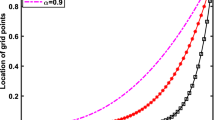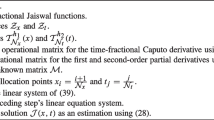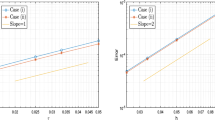Abstract
The authors of Kaur and Natesan 2023 [A novel numerical scheme for time-fractional Black-Scholes PDE governing European options in mathematical finance, (Numerical Algorithms, 94, (2023) 1519–1549)] proposed a numerical scheme, which is based on a combination of L1 scheme for time discretization and spine method for spatial discretization, for solving a Caputo temporal-fractional Black-Scholes (TBS) equation governing European options. This method is \((2-\alpha )\)-th order accurate in time and second-order accurate in space. The present work deals with the construction of a high-order numerical scheme for solving the same time-fractional problem. In this method, the \(L2-1_{\sigma }\) scheme is employed to approximate the Caputo temporal-fractional derivative, while a high-order compact finite difference (CFD) method is proposed for the approximation of space derivatives. The existence and uniqueness of the solution to the TBS model are investigated through the application of the maximum-minimum principle and the Sumudu decomposition technique. The stability and convergence of the method are investigated. The proposed method is shown to be second-order accuracy in time and fourth-order accuracy in space. Numerical experiments are performed to illustrate the accuracy of the suggested numerical scheme and validate the theoretical results. Moreover, the present numerical scheme is used for pricing the European double barrier knock-out (EDBK) option. The execution time of the present numerical algorithm is provided. In order to justify the advantage of present method, the computed results are compared with the results obtained by the methods in Kaur and Natesan 2023 [A novel numerical scheme for time-fractional Black-Scholes PDE governing European options in mathematical finance, (Numerical Algorithms, 94, (2023) 1519-1549)] and Zhang et al. 2016 [Numerical solution of the time-fractional Black-Scholes model governing European options, Comput. Math. Appl. 71 (2016) 1772-1783].









Similar content being viewed by others
Data availability
The datasets generated during and/or analyzed during the current study are available from the corresponding author on reasonable request.
References
Podlubny, I.: Fractional differential equations. Academic, New York (1999)
Mainardi, F.: Fractals and fractional calculus continuum mechanics, Springer Verlag, 291–348 (1997)
Roul, P., Goura, V.M.K.P.: A high order numerical scheme for solving a class of non-homogeneous time-fractional reaction diffusion equation. Numerical Methods for Partial Differential Equations. 37(2), 1506–1534 (2021)
Diethelm, K., Freed, A.D.: On the solution of nonlinear fractional order differential equations used in the modelling of viscoplasticity, in: Scientific Computing in Chemical Engineering II: Computational Fluid Dynamics, Reaction Engineering and Molecular Properties, Springer Verlag, Heidelberg, 217–224 (1999)
Bagley, R.L., Torvik, P.J.: On the appearance of the fractional derivative in the behavior of real materials. J. Appl. Mech. 51, 294–298 (1984)
Roul, P., Rohil, V., Espinosa-Paredes, G., Obaidurrahman, K.: An efficient computational technique for solving a fractional-order model describing dynamics of neutron flux in a nuclear reactor. Ann. Nucl. Energy 185, 109733 (2023)
Roul, P., Rohil, V., Espinosa-Paredes, G., Obaidurrahman, K.: Numerical simulation of two-dimensional fractional neutron diffusion model describing dynamical behaviour of sodium-cooled fast reactor. Ann. Nucl. Energy 166, 108709 (2022)
Roul, P., Rohil, V.: A novel high-order numerical scheme and its analysis of the two-dimensional time fractional reaction-subdiffusion equation. Numer. Algor. 90(4), 1357–1387 (2022)
Jumarie, G.: Derivation and solutions of some fractional Black Scholes equations in coarse-grained space and time. Application to Merton’s optimal portfolio. Comput. Math. Appl., 3(59), 1142–1164 (2010)
Roul, P.: A high accuracy numerical method and its convergence for time-fractional Black-Scholes equation governing European options. Appl. Numer. Math. 151, 472–493 (2020)
Liang, J., Wang, J., Zhang, W., Qiu, W., Ren, F.: Option pricing of a bi-fractional Black-Merton-Scholes model with the Hurst exponent H in [\(\frac{1}{2},1]\). Appl. Math. Lett. 23, 859–863 (2010)
Wang, X.T.: Scaling and long-range dependence in option pricing I: pricing European option with transaction costs under the fractional Black-Scholes model. Phys. A 389(3), 438–444 (2010)
Wang, J., Liang, J.R., Lv, L.J., Qiu, W.Y., Ren, F.Y.: Continuous time Black-Scholes equation with transaction costs in subdiffusive fractional Brownian motion regime. Phys. A 391(3), 750–759 (2012)
Jumarie, G.: Stock exchange fractional dynamics defined as fractional exponential growth driven by (usual) Gaussian white noise. Application to fractional Black-Scholes equations, Insurance: Mathematics & Economics. 42(1), 271–87 (2008)
Chen, W., Xu, X., Zhu, S.: Analytically pricing double barrier options based on a time-fractional Black-Scholes equation. Comput. Math. Appl. 69, 1407–1419 (2015)
Kaur, J., Natesan, S.: A novel numerical scheme for time-fractional Black-Scholes PDE governing European options in mathematical finance. Numer Algor. 94, 1519–1549 (2023)
Zhang, X., Sun, S., Wu, L., et al.: \(\theta -\)difference numerical method for solving time-fractional Black-Scholes equation. China Sci. Technol. Pap. 7, 1287–1295 (2014)
Roul, P.: VMKP Goura, A compact finite difference scheme for fractional Black-Scholes option pricing model. Appl. Numer. Math. 166, 40–60 (2021)
Cen, Z., Huang, J., Xu, A., Le, A.: Numerical approximation of a time-fractional Black-Scholes equation. Comput. Math. Appl. 75, 2874–2887 (2018)
Zhang, H., Liu, F., Turner, I., Yang, Q.: Numerical solution of the time fractional Black-Scholes model governing European options. Comput. Math. Appl. 71, 1772–1783 (2016)
Tian, Z., Zhai, S., Ji, H., Weng, Z.: A compact quadratic spline collocation method for the time-fractional Black-Scholes model. J. Appl. Math. Comput. 66, 327–350 (2021)
Alikhanov, A.A.: A new difference scheme for the time fractional diffusion equation. J. Comput. Phys. 280, 424–438 (2015)
Katatbeh, Q., Belgacem, F.: Applications of the Sumudu transform to fractional differential equations. Nonlinear Stud. 18(1), 99–112 (2011)
Adomian, G.: Solving frontier problems of physics: the decomposition method, fundamental theories of physics, vol. 60. Kluwer Academic Publishers Group, Dordrecht (1994)
Maji, S., Natesan, S.: Analytical and numerical solutions of time-fractional advection-diffusion-reaction equation. Appl. Numer. Math. 185, 549–570 (2023)
Cherruault, Y.: Convergence of Adomian’s method. Kybernetes 18(2), 31–38 (1989)
Luchko, Y.: Maximum principle for the generalized time-fractional diffusion equation. J. Math. Anal. Appl. 351(1), 218–223 (2009)
Roul, P.: A robust adaptive moving mesh technique for a time-fractional reaction-diffusion model. Commun. Nonlinear Sci. Numer. Simul. 109, 106290 (2022)
Wang, H., Sun, Y., Qian, X., Song, S.: A high-order compact difference scheme on graded mesh for time-fractional Burgers’ equation. Comp. Appl. Math. 42, 18 (2023). https://doi.org/10.1007/s40314-022-02158-w
Koleva, M.N., Mudzimbabwe, W., Vulkov, L.G.: Fourth-order compact schemes for a parabolic-ordinary system of European option pricing liquidity shocks model. Numer Algor. 74, 59–75 (2017)
Mohebbi, A., Abbaszadeh, M.: Compact finite difference scheme for the solution of time fractional advection-dispersion equation. Numer Algor. 63, 431–452 (2013)
Roul, P., Goura, VMKP., Agarwal, R.: A high-order compact finite difference scheme and its analysis for the time-fractional diffusion equation, J. Math. Chem. 61, 2146–2175 (2023)
Acknowledgements
The author thanks the anonymous referees for their insightful comments that improved the quality of the paper and is very grateful to NBHM, DAE for providing financial support under the project no. \( 02011/7/2023/NBHM (RP)/R \& D II/ 2877\).
Funding
The author received support from NBHM, DAE under the project no. 02011/7/2023/NBHM (RP)/R &D II/ 2877.
Author information
Authors and Affiliations
Contributions
Pradip Roul: conceptualization, methodology, data curation, writing—original draft, software, investigation, validation.
Corresponding author
Ethics declarations
Ethical approval and consent to participate
Not applicable
Human and animal ethics
Not applicable
Conflict of interest
The author declares no competing interests.
Additional information
Publisher's Note
Springer Nature remains neutral with regard to jurisdictional claims in published maps and institutional affiliations.
Rights and permissions
Springer Nature or its licensor (e.g. a society or other partner) holds exclusive rights to this article under a publishing agreement with the author(s) or other rightsholder(s); author self-archiving of the accepted manuscript version of this article is solely governed by the terms of such publishing agreement and applicable law.
About this article
Cite this article
Roul, P. A high-order numerical scheme and its analysis for Caputo temporal-fractional Black-Scholes model: European double barrier knock-out option. Numer Algor 98, 467–502 (2025). https://doi.org/10.1007/s11075-024-01802-2
Received:
Accepted:
Published:
Issue Date:
DOI: https://doi.org/10.1007/s11075-024-01802-2




